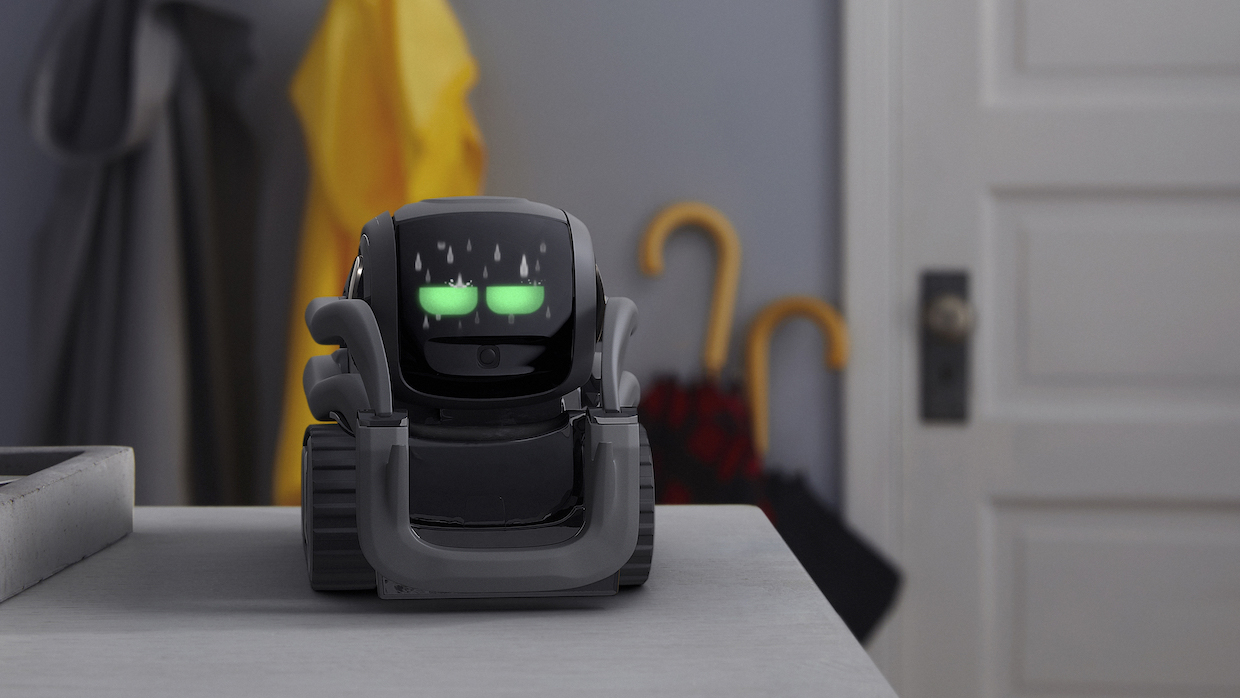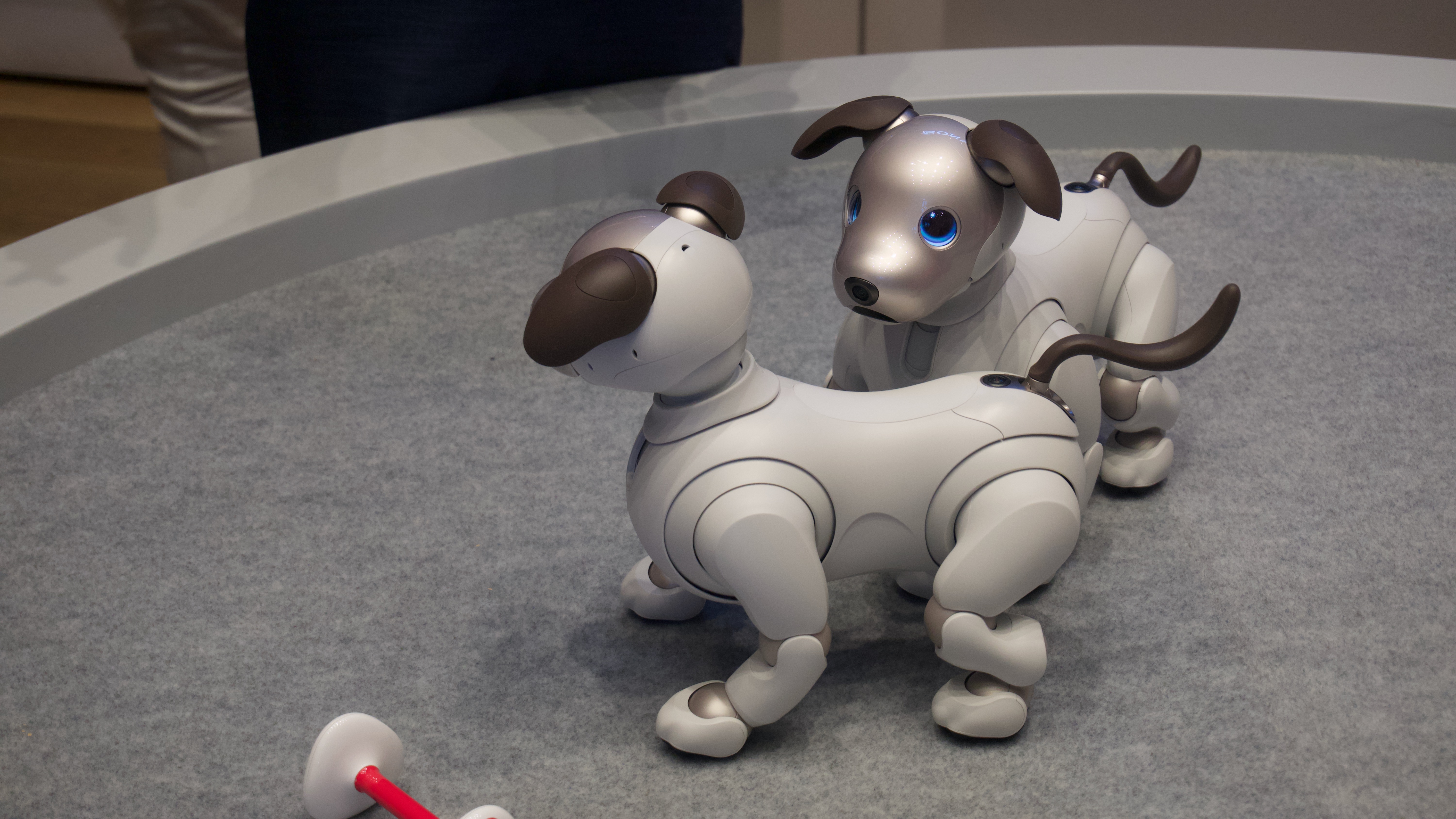Early Verdict
If you want a dog that doesn't require any housebreaking – and enjoy the idea of owning a robot without any technical knowledge – Aibo is a pricey pooch for people with money to spare.
Pros
- +
Cloud connectivity
- +
Custom tricks
- +
Grows over time
Cons
- -
Crazy expensive!
- -
Requires training
Why you can trust TechRadar
Buying Sony’s new AI-powered robo-puppy, Aibo, will cost you about the same as a purebred, show-dog: $2,899 (or around £2,250, AU$3,950).
But, unlike its canine counterparts, Aibo will never ruin your rug or whine for food ... however, it’s still liable to ignore your voice commands if you don’t give it the love and training it needs.
We got the chance to play with the pooch at Sony’s New York City headquarters, where the rebooted, 6th-generation robo-pups melted our jaded journalist hearts, due in no small part to its expressive eyes, dog-like behavior and powerful, cutting-edge innards.
Running on a Qualcomm Snapdragon 840 and Amazon’s cloud-based AWS server, Aibo can memorize up to 100 faces and learn an endless stream of new tricks – and while its intelligence certainly showed through during our demo, the tech we saw wasn’t without its kinks.
Ultimately, did a slew of sensors and neat party tricks justify its expensive pedigree? Could it stand shoulder-to-adorable-shoulder with the best toy robots on the market today? And did Aibo ever actually replace the fleshy puppers we've come to love?
Here's what we found out.

Price and release date
Back at CES 2018, Sony suggested that Aibo would retail for less than $2,000 in the US. Now, it looks like Sony thinks its newest breed of robot should cost much more.
Sign up for breaking news, reviews, opinion, top tech deals, and more.
The Aibo First Litter Edition robot will launch this September for $2,899 (around £2,269, AU$3,999). For that price, you receive a three-year Cloud subscription, access to the My aibo app, some toys – a pink ball, paw pads and an Aibone – a charging station and a customized dog tag.
This bundle will go on sale in the US ometime in September, and your dog would arrive "in time for the holidays", according to Sony's reps. An earlier version of this article said Sony was bringing the Aibo to Europe, but Sony has since confirmed that's not the case.
The discrepancy between Sony's estimated and actual price makes us wonder what kind of value Sony ascribes to its Amazon-backed AI Cloud service. With it, your pup will have access to the collective machine learning of every Aibo, which will help it become more intelligent over time in areas like object recognition.
Of course, your Aibo would also upload its experiences to the Cloud, forming a "database of memories". Note that this may or may not include uploading some data about your house and family to the Cloud for the dog to "remember", which some might see more as an invasion of privacy than a perk.
Right out of the gate, Aibo will be a premium pooch. If you wait you may find a cheaper deal on Aibo down the road, but you'll likely have to pay extra for the cloud-based edge learning (and cute accessories) that make Aibo special.

Design, specs and stats
All that said, if you're looking for a smarter breed of dog, Aibo is it. To navigate around your house, Aibo uses two cameras, six sensors, a motion detector, a light detector and four microphones – and, using the cameras, Aibo is able to memorize up to 100 faces, and can also apparently recognize and respond to your pets.
Under its adorable exterior, Aibo comes with 4GB of RAM and 32GB ROM memory to go with its Snapdragon 820 processor. All of that hardware will help Aibo understand what it's seeing through its cameras and pass data along to the cloud.
Speaking of the cloud, Aibo connects to the Cloud over your Wi-Fi network, but it can also connect via AT&T's LTE network if you take it outside your home. Aibo has a three-hour battery life, which will let it wander around your house for much longer than most other robots currently available. It'll then automatically head back to its charging station for at least a couple of hours.
In both some good and bad news, Aibo isn't open for community development – for now, Aibo doesn't appear to have a publicly available SDK for developers.

Playing with Aibo
After the on-stage unveiling, we left the Sony offices and entered into what can only be described as a puppy nursery. Pairs of Aibo models wandered around on elevated platforms while Sony reps explained how they worked and encouraged us to play with them.
As you'd expect, Aibo responds to voice commands like "Shake!", "Sit!" or "Play dead!" ... however, that's assuming it chooses to obey you. When we ordered one puppy to sit, its ears tilted back, which means the AI has detected a voice command. But instead of sitting, it just looked at us and barked.
That was a common theme of the event: the naughty pups consistently ignored about half of our commands. We were told each time to remember that these Aibo's were "fresh out of the box" and "not yet mature". Like any puppy, they need training and positive reinforcement before they understand and obey.
This struck us as rather convenient, since we could never be sure if the problem lay with the dog's personality or with the mic not properly picking up our command. But we did notice that our dog was more likely to perform easier commands, like "Sit", than more advanced commands, like "dance".

Apparently, it will take your Aibo about a year to "fully mature" and become more loyal and obedient. So an impatient, irresponsible child may not be the best choice for raising an Aibo (just like with a real puppy, it's a heady responsibility).
Still, rewarding our dog when it did obey us was undeniably endearing. Each Aibo has touch sensors on its head, beneath its chin and on its back. When you pet one, it will react with obvious pleasure, closing its eyes and leaning into the petting.
While Aibo is as energetic as most small dogs, it doesn't move as fast as one. When it walks towards you, it moves at a languid speed, its leg movements distinctly robotic. It's fair to wonder whether Aibo's little paws will handle hardwood flooring better than carpeting.
Its plodding pace made itself most obvious when trying to play "catch" with Aibo. We held out a pink, sensor-filled ball in front of Aibo, encouraging him to roll it back to us. Staring at us for a few seconds, it lifted its ears as it processed the command; then, thinking for a couple seconds, it looked down at the ball, slowly reached out a paw, placed it against the ball, and pushed it forward about six inches towards us.

Surprisingly, though, Aibo arguably handled itself better without any props, with some tricks showing it capable of complex, choreographed movements. Our personal favorite was "if you're happy and you know it...", which had the dog barking along to the popular melody.
You'll be able to download dozens of Aibo's tricks from your smartphone app as Sony releases them over time. You'll also use the app to customize your Aibo, determining things like its gender, voice pitch and eye color.
You can also train your Aibo with custom tricks. Move your Aibo's paws manually into any position you like and then click its paw buttons, and it will remember that pose. Then say "Show me your new trick!" to have it reenact your favorite yoga pose or dance move. Unfortunately, it'll only remember one custom trick at a time.

Eventually, Sony's idealized Aibo will memorize faces and voices, and will be more likely to obey commands or react happily to those who spend the most time with it.
When you're not interacting with it, Aibo will wander the rooms of your house in "watchdog" mode, scanning for intruders – though it wasn't at all clear what Aibo would do if it found someone it didn't recognize.

Sony Aibo vs Anki Vector
Of course, Aibo isn't the only smart toy on the market and could face some serious competition from Anki's new Vector robot – an app-free, roaming virtual assistant with powerful facial recognition.
There's also the similarly-priced Misty II robot that has limitless customization and DIY coding potential; the Segway Loomo that can track you for miles outside using facial recognition and littleBits' Droid Inventor Kit that teaches kids how to code.
All of these robots either have reasons to use them on a daily basis, or at least provide hours of fun learning and technical challenges as you tinker with their software.
Sony Aibo, by contrast, stands out among the group with its primarily pet-focused approach. You raise it, investing your time and energy to teach it tricks, all in the pursuit of a more lifelike experience.
The tradeoff is that, right out of the box, you can't really do all that much with it yet. Plus, you have to rely on Sony to provide fun updates rather than code the dog yourself. More casual robot owners may be fine with this, of course.

Early verdict
If you want a lifelike animal without any of the stress or mess – and enjoy the idea of owning a robot without any technical knowledge – Aibo is shaping up to be quite the companion. But if the idea of a pricey robo-pooch isn't what you'd consider the best investment, Aibo may not be the perfect pup for your family.
- These are the best smart toys

Michael Hicks began his freelance writing career with TechRadar in 2016, covering emerging tech like VR and self-driving cars. Nowadays, he works as a staff editor for Android Central, but still writes occasional TR reviews, how-tos and explainers on phones, tablets, smart home devices, and other tech.
What is a hands on review?
Hands on reviews' are a journalist's first impressions of a piece of kit based on spending some time with it. It may be just a few moments, or a few hours. The important thing is we have been able to play with it ourselves and can give you some sense of what it's like to use, even if it's only an embryonic view. For more information, see TechRadar's Reviews Guarantee.
